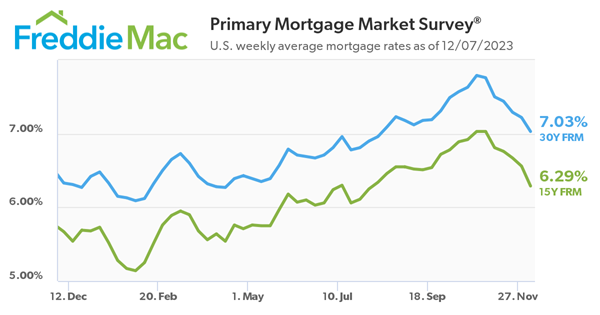Freddie Mac today (12/07/2023) released the results of its Primary Mortgage Market Survey® (PMMS®), showing the 30-year fixed-rate mortgage (FRM) averaged 7.03 percent.
“The 30-year fixed-rate mortgage averaged near 7 percent this week, down from nearly 7.80 percent just six weeks ago,” said Sam Khater, Freddie Mac’s Chief Economist. “When rates began to rapidly drop, purchase applications rebounded initially, but this improvement in demand diminished in the last week. Although these lower rates remain a welcome relief, it is clear they will have to further drop to more consistently reinvigorate demand.”

- The 30-year FRM averaged 7.03 percent as of December 7, 2023, down from last week when it averaged 7.22 percent. A year ago at this time, the 30-year FRM averaged 6.33 percent.
- The 15-year FRM averaged 6.29 percent, down from last week when it averaged 6.56 percent. A year ago at this time, the 15-year FRM averaged 5.67 percent.
The PMMS is focused on conventional, conforming, fully amortizing home purchase loans for borrowers who put 20 percent down and have excellent credit.
NAR Instant Reaction — Dr. Jessica Lautz is the Deputy Chief Economist and Vice President of Research at the National Association of REALTORS®.
The mortgage market continues to improve for home buyers. The 30-year fixed mortgage interest rate hit an average of 7.03% this week. In just 6 weeks of decline, this makes a considerable difference for a home buyer purchasing a $400,000 home. A monthly mortgage payment of $2,135 is a monthly savings of $166. This is considerable, and buyers who have been priced out may start to trickle back in.
For home buyers who are taking on a mortgage to purchase a home and have been wary of the autumn rise in mortgage rates, the market is turning more favorable, and there should be optimism entering 2024 for a better market.
It should be noted that in the most recent months’ data in the REALTORS® Confidence Index, 29% of the market is purchasing a home without the use of a mortgage. These buyers are likely indifferent to the mortgage market. Some are investors, but many are primary residence buyers who have built substantial housing equity amid home price gains. While some of these buyers may be local, others may be moving long distances to a more affordable area.
For now, eyes are on the Feds statements, CPI, and the 10-year treasury to see what the end of the year holds for mortgage interest rates. For those interested—join NAR’s Real Estate Forecast Summit on Dec. 12 for a more in-depth forecast.


 Facebook
Facebook
 X
X
 Pinterest
Pinterest
 Copy Link
Copy Link

